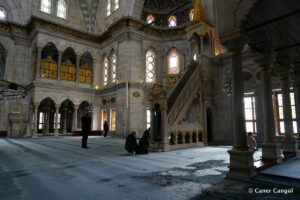Nuruosmaniye Camii
- Tür: Cami, Külliye
- Tema: Selatin Camileri, UNESCO Dünya Mirası Geçici Listesi
- Kültür: Osmanlı
- Yüzyıl: 18. yy
- Bölge: Türkiye, Marmara Bölgesi, İstanbul, Fatih, Mollafenari
| Nuruosmaniye Mosque | |
|---|---|
 | |
| Religion | |
| Affiliation | Sunni Islam |
| Location | |
| Location | Istanbul, Turkey |
| Geographic coordinates | 41°00′37″N 28°58′14″E / 41.010234°N 28.970540°E |
| Architecture | |
| Architect(s) | Simon Kalfa |
| Type | Mosque |
| Style | Ottoman Baroque |
| Groundbreaking | 1748 |
| Completed | 1755 |
| Specifications | |
| Height (max) | 43.5 metres (143 feet) |
| Dome dia. (inner) | 25 metres (82 feet) |
| Minaret(s) | 2 |
The Nuruosmaniye Mosque (Turkish: Nuruosmaniye Camii) is an 18th-century Ottoman mosque located in the Çemberlitaş neighbourhood of Fatih district in Istanbul, Turkey, which was inscribed in the Tentative list of World Heritage Sites in Turkey in 2016.[1]
Designed by a Greek non-Muslim architect named Simeon Kalfa, the Nuruosmaniye mosque was the first monumental Ottoman building to exemplify the new Ottoman baroque style, which introduced baroque and neoclassical elements from Europe.[2][3][4][5] The mosque's ornamentation and its curved courtyard display its baroque influences. The dome of the mosque is one of the largest in Istanbul. The mosque is part of a larger religious complex, or külliye, acting as a centre of culture, religion, and education for the neighborhood.
In Constantinople, the area of the Nurosmaniye Mosque was close to the Forum of Constantine, where the Column of Constantine (Turkish: Çemberlitaş Sütunu) still stands. Surrounding the mosque is Istanbul's Grand Bazaar (Turkish: Kapalıçarşı). After the construction of the Sultan Ahmed Mosque, the Nurosmaniye mosque was the first imperial mosque to be built in 100 years.[6]
- ^ "Nuruosmaniye Complex". UNESCO World Heritage Centre. UNESCO. Retrieved 8 June 2018.
- ^ "Nuruosmaniye Complex". whc.unesco.org. UNESCO. Retrieved 2023-04-27.
- ^ Freely, John (2000). Inside the Seraglio: Private Lives of the Sultans in Istanbul. Penguin Books. p. 211. ISBN 978-0-14-027056-3.
- ^ Freely, John; Glyn, Anthony (2000). The Companion Guide to Istanbul and Around the Marmara. Boydell & Brewer. p. 104. ISBN 978-1-900639-31-6.
- ^ Suman, Selva (2011). "Questioning an "Icon of Change": The Nuruosmaniye Complex and the Writing of Ottoman Architectural History" (PDF). METU Journal of the Faculty of Architecture: 145–166. doi:10.4305/METU.JFA.2011.2.7.
- ^ Rüstem 2019, p. 111.
























